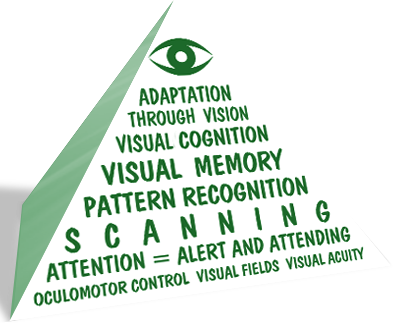The course consists of 17 recorded lessons and provides a total of 8 continuing education contact hours. The CE hours are awarded and documented on a downloadable course completion certificate. The certificate is automatically released following successful completion of the final quiz in Lesson 17.
This overview course focuses on providing practical information that the OT can apply immediately when working with their adult clients with acquired brain injury (ABI) from stroke and TBI. The first three lessons provide background information to assist the learner to understand how vision and subsequently vision impairment influences occupational performance and the rationale for OT intervention. Lesson 1 describes normal visual processing and how vision contributes to completing daily occupations. Lesson 2 introduces the visual perceptual hierarchy framework (Warren, 1993) that will be used as the framework for selecting appropriate assessments and interventions. Lesson 3 describes the OT approach. The remaining lessons cover the four most frequently impaired areas of visual processing: acuity, oculomotor control, visual field and visual attention (e.g. neglect). The lectures describe key clinical observations and screening assessments along with OT interventions that enable the client to compensate for the vision impairment to participate in valued activities and occupations. The OT role in addressing vision impairment is compared to that of other members of the rehab team to clarify referral and collaboration.
Learning Objectives
- Describe how the relationship between vision, prediction, and context enables us to successfully complete occupations; the negative impact of vision impairment on this relationship and its subsequent effect on occupational performance.
- Describe the visual perceptual hierarchy framework that guides OT approach to rehabilitation of the adult client with visual processing deficits from stroke and TBI.
- Describe the OT focus and role in addressing vision impairment occurring in adults following stroke and TBI.
- Relate the client’s limitations in visual processing to their limitations in occupational performance.
- Identify and describe key clinical observations and screening assessments that indicate a visual processing impairment in the adult client.
- Identify when it is appropriate to consult with another vision professional to ensure the client is able to complete all desired occupations.
- Identify and describe key intervention strategies that enable the client to compensate for the visual processing impairment and participate in daily occupations.
FOLLOW THESE STEPS TO START THE LESSONS
- Each lesson contains a recorded lecture, downloadable handouts including a pdf of the powerpoint lecture in a 3 slide per page format for you to take notes. Click on the Materials button (shown above) to access these items.
- Each lesson also contains a short quiz comprised of 2-5 multiple choice questions to help you assess what you learned from the lesson. Be sure to complete the quiz before you leave the lesson.
- Before you go any further click on the Materials button (shown above) and listen to the Course Overview recorded lecture.
